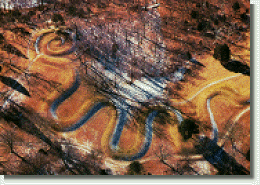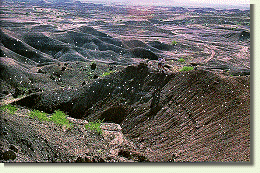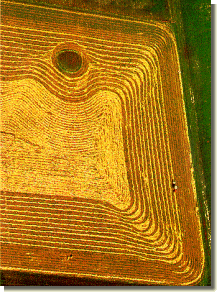
|
How do sites come to the attention of archaeologists in the first place?
1. Some sites are never really 'lost':
- The living history of an archaeological site is often remembered by the living inhabitants of the area.

|
'Great Serpent Mound (Ohio, U.S.A.)
Built between 500-100 BC, used for ceremonial occasions
|
|

|
Hadar, Etheopia where many of the earliest sites have been exposed through erosion, including evidence of early hominids
|
|
2. Some sites are found accidentally:
- For instance, someone digging in his garden.
3. Some archaeologists conduct reconnaissance --a preliminary survey to learn information.
a) Aerial and remote (satellite) reconnaissance for sites. Main techniques:
which occur when a buried wall or ditch either decreases or enhances crop growth by changing the availability of moisture and nutrients through changing the depths of soil. Wheat, barley, and some root vegetable are good for exhibiting this phenomenon.
Earthworks- is often used to describe banks and related ditches or stone walled features, many of which can be seen in relief—a sharpness to the outline of the object due to a contrast in colour and or shape. These features are often visible in the form of shadow marks - which depend on the weather and the amount of sunlight. These features become visible as relief shadows are cast distinguishing their silhouettes.

|
Bronze Age Burial Mound tht has been preserved in a wheat field in Wiltshire, England
|
Soil-marks- show the presence of buried ditches, banks or foundations through changes in the subsoil colour caused when a plowshare ( the part of a moldboard plow that cuts into the soil) catches and turns over part of the buried feature, bringing it to the surface. Most soil-marked sits are being destroyed by modern cultivation; they are mostly visible in photographs taken in winter months. Bare soil will also sometimes reveal features through the amount of water they retain -damp-marks- or differences in thermal properties that affect the melting of snow and frost.
b) Judgmental reconnaissance-
- This entails walking around looking for the most 'likely' places for sites. This would include locales near fresh water, on flat land, near food resources. This procedure includes talking to people to get information and knowledge to find sites.
c) Archaeological site reconnaissance based on random/ probabilistic (most likely)/ systematic sampling designs to improve judgement.
- i.e. a river may have deepened, changed direction, or even disappeared. Sea levels and sea shores change; 12,000 years ago Victoria, British Columbia was much like Saskatchewan is today, with many hills and sparse trees.
- i.e. cross culturally: biased about what, where and how people lived. Different cultures often look for different criteria to meet these informational needs.
|



